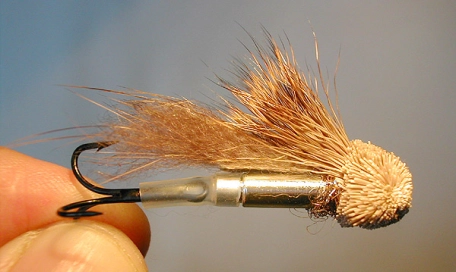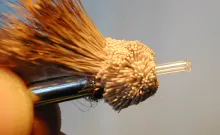Yep! It's yet another one of that Danish madman's muddlers. This time with an even longer name: The Short Heavy Chicago-Zürich-Copenhagen Delayed Nutria Tube Muddler or SHCZCDNTM for easier remembering!
Yep! It's yet another one of that Danish madman's muddlers. This time with an even longer name: The Short Heavy Chicago-Zurich-Copenhagen Delayed Nutria Tube Muddler.
Well... I will now attempt to drag the much tormented GFF audience through yet another incarnation of my beloved tube muddler. I have tempted fate before, doing my best to scare you off with the original Nutria muddler, the original tube muddler, the first Chicago-incarnation and now the second. I cannot promise that this journey is over. I have a few more unfisnished ideas and experiments in my boxes, which might make their way to these pages.
This new fly imitates a small sculpin quite well. Not least the fact that sculpins are bottom seeking fish. The fly really dives deep thanks to the metal tube it is tied on.
The fly has excelled when fishing for trout in the darkness - both in salt and fresh water. It moves a lot of water and goes to the depths even in a current. The only real disadvantage is the same as its advantage: its weight. Casting it can be a challenge, not least in total darkness.
All images are clickable. Click to see a larger copy.
Materials
Tube: Bidoz aluminium tube 22 millimeters. Brass may be chosen for a heavier fly
Thread: 6/0 brown
Tail: Nutria zonker strip. Mink or rabbit can be used as alternatives
Dubbing: Angel hair or other shiny dubbing, copper, orange or red
Head: Spun natural deer hair
Sleave: Clear silicone tubing
Hook: Treble tube hook size 6 or 8. Single or double hook can replace this according to taste and rules
Notes on a vice for the Bidoz tubes:
Theses short tubes can be tied on any tube vice that has a suitable diameter center rod. I use a Fisker tube tool and a large needle for the prupose. The combination holds the tube firmly. I line the metal tube with plastic after having tied the fly. That is possible with this particular fly, and gives me the option to use a larger diameter pin to hold it, resulting in more stability.
|
|
|
|
|
|
|
|
|
|
|
|
|
|
|
|
|
|
|
|
|
|
|
|
|
|
|
|
|
|
|
|
|
|
|
|
|
|
|
|
- I use a Bidoz aluminium tube for the fly. A brass tube is also an option if you want an even heavier fly. Attach the thread just behind the conical part of the tube.
- The fur is my preferred zonker strip material nutria, but mink or rabbit is useful too.
- I trim the fur fairly short. I do not want it to interfere with the hook. The flash dubbing is Angel Hair - in this case a coppery brown color. I add a collar of the dubbing just in front of the fur strip.
- Select deer hair that is fairly straight and well suited for muddlers. I personally prefer the natural hair, but dyed hair can of course also be used.
- Clip a small bundle of hair, no thicker than a pencil. You can stack it or leave it a bit uneven according to taste.
- Match the hair to the fly by grabbing the tips and measureing the bundle over the fly.
- Trim the butt end of the hair so that the tips are about twice as long as the butts when measured from the spot where you will tie in the hair.
- Holding the hair tightly and close to the tube, catch them with a couple of loose thread wraps.
- Tighten the wraps upwards without letting god of the hair. The butt ends will flare and create the first part of the head. Do not let the hair rotate on the tube, but keep the hair collar formed on the "top" of the tube.
- When you let go of the hair, the result is a collar on the top of the tube, formed by the tips and the beginning of the head, also on the top of the tube.
- Notice how the underside of the fly is still bare.
- Cut a new bundle of hair like the previous from the skin. Cut off the tips to form short, uniform hairs.
- Place this in front of the first bundle, stroking back the already tied in and flared hair. Hold tight, catch with a couple of wraps, tighten and do not let go.
- The bare tube is still visible under the fly.
- Cut a third bundle of hair like the previous ones. Again trim off the tips to form short, uniform hairs. Tie in the third bundle under the tube over the bare part in a manner similar to the first bundle. Hold tight, catch with a couple of wraps, tighten and do not let do.
- The fly now looks quite messy, but trust me, these three bundles will form a nice muddler head when we are done.
- Pull back the hairs in front of the fly and work the thread onto the bare tube. The small collar on the metal tube will keep it from dropping over the front of the fly.
- Use a half hitch tool or the tip of a pen to half hitch or whip finish over the tip of the tube behind the metal collar. Wrap the thread around the tool a couple of times, press the tool over the tip of the tube to press back the hairs and pass the thread wraps off the tool and onto the metal tube. Do this a couple of times and cut off the thread.
- The fly now looks like something the cat left on your pillow.
- Trim the head with a good pair of serrated scissors. Leave it in the vice or hold it in your hand. In both cases rotate it and trim in small, incrimental steps, constantly checking your progress. Cut only from the front of the fly with your scissors at an angle pointing towards the tips of the deer hair collar. Read more about this process in this muddler article
- First step is the basic head size and shape. Leave the front hairs that stick out over the tube and most of the butt ends to the rear of the head and of course all of the hair collar formed by the tips of deer hair.
- Now trim the absolute front of the fly with the scissors perpendicular to the tube.
- The result should be an evenly rounded head. Trim in very small steps, constantly checking your progress by removing the cutoffs and asessing your work.
- The remains of the butts in the back of the head are cut off by pressing down the tips with one leg of the scissors and cutting perpendicular to the fly.
- Doing like this all the way around the fly will result in an almost perfectly conical head.
- Now remains only the final trimming to obtain a smooth surface and to get rid of stray hairs. Stroke the trimmed head back and forth a few times to reveal uneven hairs, trim again and the final result should be a nice and even muddler head.
- You now need to line the tube with a thin plastic tube. Stick it through the tube from the rear and melt it to form a small collar.
- Pull the inner tube back to fit tightly in the front and trim the rear end leaving a short piece to melt down to a collar here. Stroke the zonker strip and deer hair collar forwards and melt the protuding inner tube to form a collar securing it.
- After melting the tube might be closed. Use a needle to reopen it.
- The finished fly - here with a furry treble hook - is a very good sculpin imitation. The furry treble is simply made by tying in a couple of small bunches of the wing material on the hook and varnishing the base.
When tying on the fly, remove the hook from the rear of the fly, pass the tippet through the tube and tie it onto the hook. Now pull the tippet, resetting the hook into the rear silicone tubing.
- Log in to post comments







































